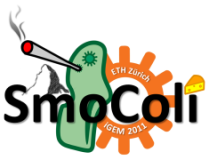Team:ETH Zurich/Biology/MolecularMechanism
From 2011.igem.org
| Circuit design |
| ||||
| We combined a smoke-sensitive band-pass filter with GFP output with a quorum-sensing diffusive mechanism that alarms the user of the system to high xylene levels by expressing RFP. | |||||
BandpassWhere it comes from...In 2005 Ron Weiss et al. constructed the first band-pass filter device in synthetic biology. Therfore he combined a high pass and a low pass filter. A input signal is proceed by cell to cell communication while the signal processing is a intracellular feed forward loop. Filters are create by using different transcriptional regulator proteins with different repression efficiency and binding affinities for corresponding promoters.
How we used itWe used his pioneering network design as a basis in the planing process for our band-pass filter implementation [9]. Instead of cell-cell communication via AHL for input signal, we included our different smoke detectors which detects volatile small molecules like acetaldeyhde or xylene. |
Quorum sensing of the alarmsystemWhere it comes from...The luminescence operon in Vibrio fischeri is regulated by the transcriptional activator (LuxR). The lux box is a 20 bp inverted repeat sequence at a position centered 42.5 bases upstream of transcriptional start. LuxR binds to the lux box in presents of AHL and enhance its expression. LuxR is needed to activate the σ70 RNA Polymerase. The Vibrio fischeri lux operon consists of seven genes, the first one is luxI. The luxI gene encodes for the enzyme for AHL synthesis. The autoinducer AHL is secrete by the cells to coordinate gene expression based on the local density of the bacterial population. Furthermore transcription of luciferase in the lux operon is induced, leading to bioluminescence. How we used itFor our system we used a Promoter which is repressed by luxR!(BBa_R0061) It was designed by placing the lux box between and partially overlapping the consensus -35 and -10 site of an artificial lacZ promoter. In presents of AHL LuxR binds to the lux box and inhibits binding of the RNA Polymerase. [7] |
Plasmid design Plasmid design for the AlcR system Transcriptional terminators included for each gene. Plasmid copy numbers adapted from [4]. For the biological implementation of the SmoColi system, we constructed a three-plasmid system with different antibiotic resistances. This setup was chosen in order to clone the whole SmoColi system into the same bacterial cells. The vectors used in our setup are the parts pSB6A5, pSB3C5, pSB3K3 and pSB4K5. These plasmids contain different origins of replication, thus resulting in different copy numbers of the correlating plasmid in e.coli. pBR322, p15A and pSC101 origins are used as a stable three-plasmid system [3]. The copy number influences the amount of protein produced by the cell and plays a crucial role in our design, especially for the bandpass filter. Depending on the function of a particular protein in our system we had to evaluate on which plasmid the corresponding gene should be cloned. In the xylene-responsive system we included an artificial degradation pathway (xylWCMABN) so that we could establish a xylene gradient. For this purpose the plasmid pCK04AxylR was added [1]. To avoid incompatibilities of plasmids we adapted the rest of our system and changed the composition of the genes on each vector compared to the AlcR system. |
Cloning strategyGeneral procedureBy cloning our parts we tried to stick as much as possible to the strategies proposed in the registry of standard biological parts [5]. The general cloning scheme was performed as follows:
Sources of genes and promoters |
Definition of ribosome binding sites Different ribosome binding sites and their estimated strengths which are included in our design. The strengths of the sequences were estimated with a RBS strength calculator [7]. In the last column it is listed in front of which genes a particular RBS was added. Another important role in the synthesis of proteins plays the ribosome binding site (RBS), where the ribosomes are bound to the mRNA at the initiation of the translation process. The ribosome binding sites which we included in our system were designed in several different ways:
The strength of all the ribosome binding sites used was estimated with a RBS calculator [7]. Although the efficiency of protein synthesis is not directly proportional to the estimated values, they can still indicate whether a certain RBS is more or less strong. Below you can find a list of the different ribosome binding sites used, their estimated binding strength and in front of which genes they were put.
|
References[1] [http://aem.asm.org/cgi/content/abstract/64/2/748 Sven Panke, Juan M. Sánchez-Romero, and Víctor de Lorenzo: Engineering of Quasi-Natural Pseudomonas putida Strains for Toluene Metabolism through an ortho-Cleavage Degradation Pathway, Appl Environ Microbiol, February 1998, 64: 748-751] [2] [http://www.nature.com/nature/journal/v434/n7037/full/nature03461.html Subhayu Basu, Yoram Gerchman1, Cynthia H. Collins, Frances H. Arnold & Ron Weiss: A synthetic multicellular system for programmed pattern formation, Nature 2005, 434: 1130-11342] [3] [http://www.springerlink.com/content/3fj1xxl9p42kx8l5/ Karl Friehs Plasmid Copy Number and Plasmid Stability, Advances in Biochemical Engineering/Biotechnology, 2004, 86: 22-192] [4] [http://openwetware.org/wiki/Arking:JCAOligoTutorial8 OpenWetWare Arking:JCAOligoTutorial8, 0 Jul 2008, 04:32 UTC. 21 Sep 2011, 01:32] [5] [http://partsregistry.org/Help:Contents Registry of Standard Biological Parts Help:contents 21 Sep 2011, 02:59] [6] [http://partsregistry.org/Ribosome_Binding_Sites/Prokaryotic/Constitutive/Anderson J. Christopher Anderson Ribosome Binding Sites/Prokaryotic/Constitutive/Community Collection Registry of Standard Biological Parts, 21 Sep 2011, 08:49] [7] [] [8] [http://jb.asm.org/cgi/content/abstract/182/3/805 Kristi A. Egland and E. P. Greenberg: Conversion of the Vibrio fischeri Transcriptional Activator, LuxR, to a Repressor , Journal of Bacteriology, 2000, 182: 805-811] [9] [http://www.nature.com/nature/journal/v434/n7037/full/nature03461.html Subhayu Basu, Yoram Gerchman1, Cynthia H. Collins, Frances H. Arnold & Ron Weiss: A synthetic multicellular system for programmed pattern formation, Nature 2005, 434: 1130-11342] |
 "
"


